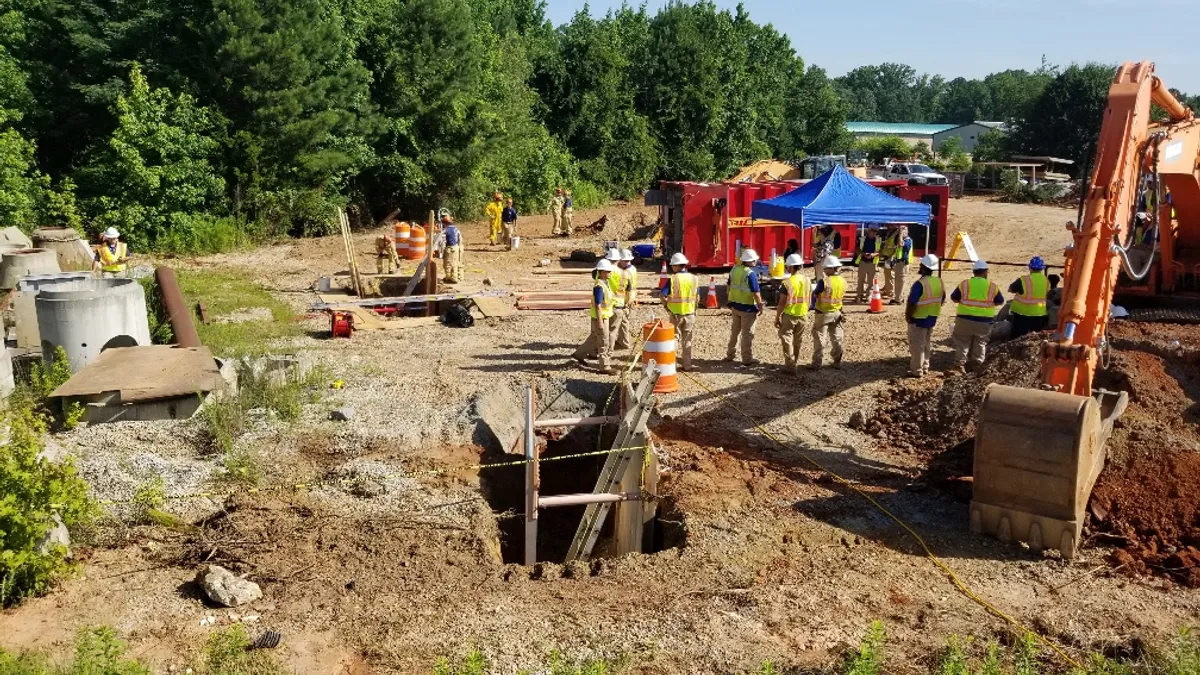“It happens instantaneously,” said Emil Szotko, construction safety specialist for OSHA’s Region 5 in Chicago.
When a construction trench caves in, the force is powerful and dangerous for those working inside; their fate is often sealed immediately.
“Working in trenches is a very dangerous job, because most of the time, when trenches collapse, it’s a recovery mission, not a rescue,” Szotko told Construction Dive.
The National Utility Contractors Association named June as National Trench Safety month, an opportunity for contractors to find time to host toolbox talks, webinars or safety stand downs to discuss best practices for working in excavations.
In 2016, NUCA narrowed the focus, designating the third week of June for its National Trench Safety Stand Down. Partnering with stakeholders like United Rentals and Sunstate Equipment, NUCA collects materials, hosts webinars and calls for stand downs to focus on trench safety.
Mike Flowers, director of safety, training and education for NUCA, told Construction Dive the resources are for all contractors who work with excavations or underground — encouraging those who could use the information to take the time to assess and review best practices.
“It’s really just reinforcing why there’s guidelines and why there’s standards and why we need to abide by them,” Flowers said.
National emphasis
In 2022, 39 workers died in trench collapses, more than double the year before, Szotko told Construction Dive. Since Oct. 1, the start of OSHA’s fiscal year 2023, there have been 11 deaths.
“I don’t want to jinx it, but 11 is still a lot of trench fatalities, given that it is so preventable,” Szotko said. “We need to make sure people know to bench it, shore it, shield it, slope it,” he said, echoing OSHA’s guidance around ways to fortify a trench.
Last summer, OSHA responded to the swift increase in trench deaths with a national emphasis program, designed to raise awareness around excavation hazards. To date this fiscal year, Szotko said the agency has conducted over 1,100 trench inspections with around 530 unsafe conditions abated — meaning they were fixed with proper documentation shared with OSHA.
Sometimes that’s done while the OSHA inspector is still on the job, Szotko said, but there is still room for improvement. Sometimes, that can be enforced after the fact, as a deterrent.
For example, a July 2022 trench collapse that caused the death of one worker resulted in over $375,000 in initial fines for Manchester, Connecticut-based contractor Botticello. In March, the company owner and equipment operator were arrested; they now face criminal charges for manslaughter and reckless endangerment.
The company allegedly failed to provide the required safeguards to prevent the collapse, triggering citations for three willful violations. The contractor had previously faced four serious violations from trenching work in 2015, according to OSHA. Botticello is contesting the fines.
Toolbox talks and refreshers
NUCA chapters across the U.S. will host events for members this week to refresh their safety knowledge.
At NUCA Nebraska’s chapter, events were hosted early, on June 9, said Janet Seelhoff, president of public relations firm McBride & Associates, which represents NUCA. About 150 attendees listened to a toolbox talk refresher, and chatted with an OSHA representative. The overall takeaway was was “don’t take short cuts, safety should always be top of mind,” Seelhoff said.
Walter Kusmenko is also reinforcing the importance of trench reinforcement.
A field health and safety supervisor for Lodi, New Jersey-based Montana Construction, Kusmenko said he regularly has over 100 workers on 20 jobs. He tries to visit each jobsite to ensure new workers are following proper safety protocols.
“Any new guys, we’ll have a 10- to 15-minute talk everyday next week, visiting three to five jobs a day, get to everyone,” he said.
Though he takes the initiative to visit jobsites, Kusmenko said it’s important to ensure everyone on the jobsite knows best practices — from the workers in the trench speaking up if a trench isn’t properly protected, to the superintendents keeping a watchful eye.
“It’s good to hear not from me, it’s good for the foreman to contribute and the super to contribute and even the laborers, it’s good for them to ask questions,” Kusmenko said. “Let them do some of the talking.”
Speed kills
Experts told Construction Dive that working too fast is the biggest contributing factor that leads to employees laboring in trenches without the proper protection.
Whether from the higher ups in the office or the superintendent on the jobsite, pushing to meet schedules can mean skipping vital steps to protect the men and women working in the excavation.
“I think it starts with the company culture,” Szotko said. “They have to care about employees.”
Flowers echoed that sentiment, saying, “someone’s got to have your employees’ back.”
“You can’t compromise safety just to meet a deadline,” he added.






















